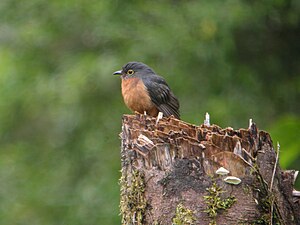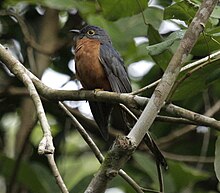Rust-bellied cuckoo
| Rust-bellied cuckoo | ||||||||||
|---|---|---|---|---|---|---|---|---|---|---|

Rust-bellied cuckoo, Papua New Guinea |
||||||||||
| Systematics | ||||||||||
|
||||||||||
| Scientific name | ||||||||||
| Cacomantis castaneiventris | ||||||||||
| ( Gould , 1867) |
The rust-bellied cuckoo ( Cacomantis castaneiventris ) belongs to the order of the cuckoo birds (Cuculiformes) and to the family of the cuckoos (Cuculidae). Like many species of cuckoo birds, the rust-bellied cuckoo is an obligatory brood parasite . As is characteristic of the genus Cacomantis , the bush cuckoo is an extremely small species of cuckoo. Unlike most cuckoos, there is no noticeable gender dimorphism . The species has so far been little researched compared to other cuckoo species.
The distribution area of the rust-bellied cuckoo extends over New Guinea and the extreme northeast of Australia. Three subspecies are described.
The IUCN classifies the species as not endangered (least concern).
features
Body measurements and physique
The rust-bellied cuckoo reaches a body length of 22 to 24 centimeters. Its appearance is reminiscent of the fan-tailed cuckoo , but it is significantly smaller and overall darker.
Of the body length, the males have an average of 11.5 centimeters on the tail plumage. The tail plumage of the females is slightly shorter and measures an average of 11.4 centimeters. The wings are an average of 11 centimeters long in both sexes. The beak is on average 2.1 centimeters long. They weigh between 32 and 38 grams.
The iris is dark brown, the eye ring is pale yellow. The beak is blackish gray. In some individuals, the base of the beak of the lower mandible is reddish orange. The inside of the beak is salmon-colored to orange-red. The feet and legs are yellow to yellow-orange.
Appearance of adult rust-bellied cuckoos

In both sexes, the head, the nape of the neck, the back neck and the upper side of the body as well as the wings are dark blue-gray. The flight feathers are gray-brown on the top. On the underside, the wings are glossy dark gray with a large white area at the base of the hand wings. They form the white stripe characteristic of the genus.
On the underside of the body, both sexes are red-brown to fox-colored. The chin, fore neck and the sides of the neck are set off sharply against the dark blue-gray top of the body. In certain lighting conditions, the chin can appear slightly gray.
Appearance of young birds
In juveniles, the head, the back neck and the upper side of the body are brownish and merge into a more intense reddish brown on the rump and the upper tail-coverts. On the other hand, they are whitish on the throat. On the front neck and chest they are light brown, the belly and flanks are whitish, while the under tail-coverts are light brown. The tail plumage is dark brown, all control feathers are very narrow red-brown border. The outermost control feathers are cross-banded reddish brown in some individuals.
The beak in young birds is black with a brownish tinge around the nostrils. The base of the lower mandible is yellow-brown and the inside of the beak is brownish-yellow. The legs and feet of young birds are still dull, the claws are black.
Distribution area
The distribution area of the rust-bellied cuckoo is Australasia . It includes the islands of Misool , Salawati , the Aru Islands , New Guinea , the Yapen Island and the Australian Cape York Peninsula . The Ari Islands and New Guinea are considered to be the focus of distribution of the species. The distribution area in Australia extends to the region around the city of Cooktown .
The few ringed birds, on the other hand, indicate that they were true to their location, since all ringed birds were recovered less than 10 kilometers from their original location. The fact that rust-bellied cuckoos are regularly observed in Australia that are molting, indicates that rust-bellied cuckoos are more resident birds . It is believed, however, that rust-bellied cuckoos occasionally roam Torres Strait and thus switch between the Australian continent and New Guinea.
The individual subspecies occur in the following regions:
- C. c. arfakianus Salvadori , 1889: Distribution area are islands off the coast in western New Guinea and the western part of New Guinea. In New Guinea the distribution area extends from the Vogelkop to the Fly River .
- C. c. weiskei Reichenow , 1900: The distribution area includes the east of New Guinea including the Huon Peninsula .
- C. c. castaneiventris ( Gould , 1867): The distribution area of the nominate form includes the Aru Islands and the extreme northeast of Australia.
The habitat of the rust-bellied cuckoo are dense, moist monsoon rainforests, forest edges, eucalyptus forests and, in Australia, thickets along watercourses and also savannas with thickets.
Way of life
Little is known about the way of life of this small cuckoo species. This low level of knowledge also contributes to the fact that rust-bellied cuckoos are only noticeable when they call and are otherwise barely noticeable in the dense foliage of the treetops, where they are mostly found. The diet consists of beetles, grasshoppers and caterpillars, as well as ticks. Rust-bellied cuckoos mostly look for food in the treetops and only occasionally come to the ground to look for food. They also occasionally catch insects in flight. As a rule, rust-bellied cuckoos live solitary, only very rarely are they observed in association with other bird species.
The rust-bellied cuckoo is an obligatory breeding parasite, which means that a female lays a single egg in the nest of a host bird species. The host bird species are not exactly known, as both the bush cuckoo and the fan- tailed cuckoo lay very similar eggs to the rust-bellied cuckoo . According to current knowledge, however, fan tails belong to the parasitized bird species. Erhitzøe et al. name three periods in which rust-bellied cuckoos lay eggs in Australia: June to August, September and October and December to January.
literature
- Bruce M. Beehler & Thane K. Pratt: Birds of New Guinea: Distribution, Taxonomy, and Systematics Princeton University Press, Princeton, New Jersey, 2016, ISBN 978-0691164243 .
- NB Davies: Cuckoos, Cowbirds and Other Cheats . T & AD Poyser, London 2000, ISBN 0-85661-135-2 .
- PJ Higgins (Editor): Handbook of Australian, New Zealand & Antarctic Birds: Volume 4 Parrots to Dollarbird . Oxford University Press, Melbourne 1999, ISBN 0-19-553071-3 .
- Johannes Erhitzøe, Clive F. Mann, Frederik P. Brammer, Richard A. Fuller: Cuckoos of the World . Christopher Helm, London 2012, ISBN 978-0-7136-6034-0 .
Web links
Single receipts
- ↑ a b Handbook of the Birds of the World on the Rostbauchkuckuck , accessed on November 26, 2017
- ↑ a b c d e Erhitzøe, Mann, Brammer, Fuller: Cuckoos of the World . P. 388.
- ↑ a b Higgins (HSG.): Handbook of Australian, New Zealand & Antarctic Birds: Volume 4 Parrots to Dollarbird . P. 688.
- ↑ a b Erhitzøe, Mann, Brammer, Fuller: Cuckoos of the World . P. 389.
- ↑ a b Higgins (HSG.): Handbook of Australian, New Zealand & Antarctic Birds: Volume 4 Parrots to Dollarbird . P. 689.
- ↑ Higgins (HSG.): Handbook of Australian, New Zealand & Antarctic Birds: Volume 4 Parrots to Dollarbird . P. 690.
